Airflow 3 and Airflow AI SDK in Action - Analyzing League of Legends
Learn Key Airflow 3 and AI Features Through a Practical League of Legends Data Project
It is February 7th and I hold my passport with a valid U.S. visa in my hands. I am officially an alien with extraordinary ability and the dream has come true, I can now relocate with my family to California.
 My I-797B approval notice, so much work went into getting this document, source: by author
My I-797B approval notice, so much work went into getting this document, source: by author
It all started with a motorcycle, a map, and the endless California sunshine. Years ago, my wife and I took a sabbatical, trading Hamburg’s grey skies for the Pacific Coast Highway, and just… explored. We fell in love: the landscapes, the energy, the feeling that anything was possible. The O-1A? That wasn’t even on my radar back then. I was just a Data Engineer with a dream.
 Our home on two wheels during our roadtrip in 2017, source: by author
Our home on two wheels during our roadtrip in 2017, source: by author
Fast forward to 2023: add two kids, a booming career back in Germany, and a longing that hadn’t faded. I knew I had to take action and make that dream our new reality. We did another trip to California, staying in Los Angeles for some weeks with our kids. They loved it, we were convinced. For the next 18 months, I explored all options, became a hobby immigration lawyer, spent endless hours building a profile, and finally found a way forward – working harder than I ever thought possible.
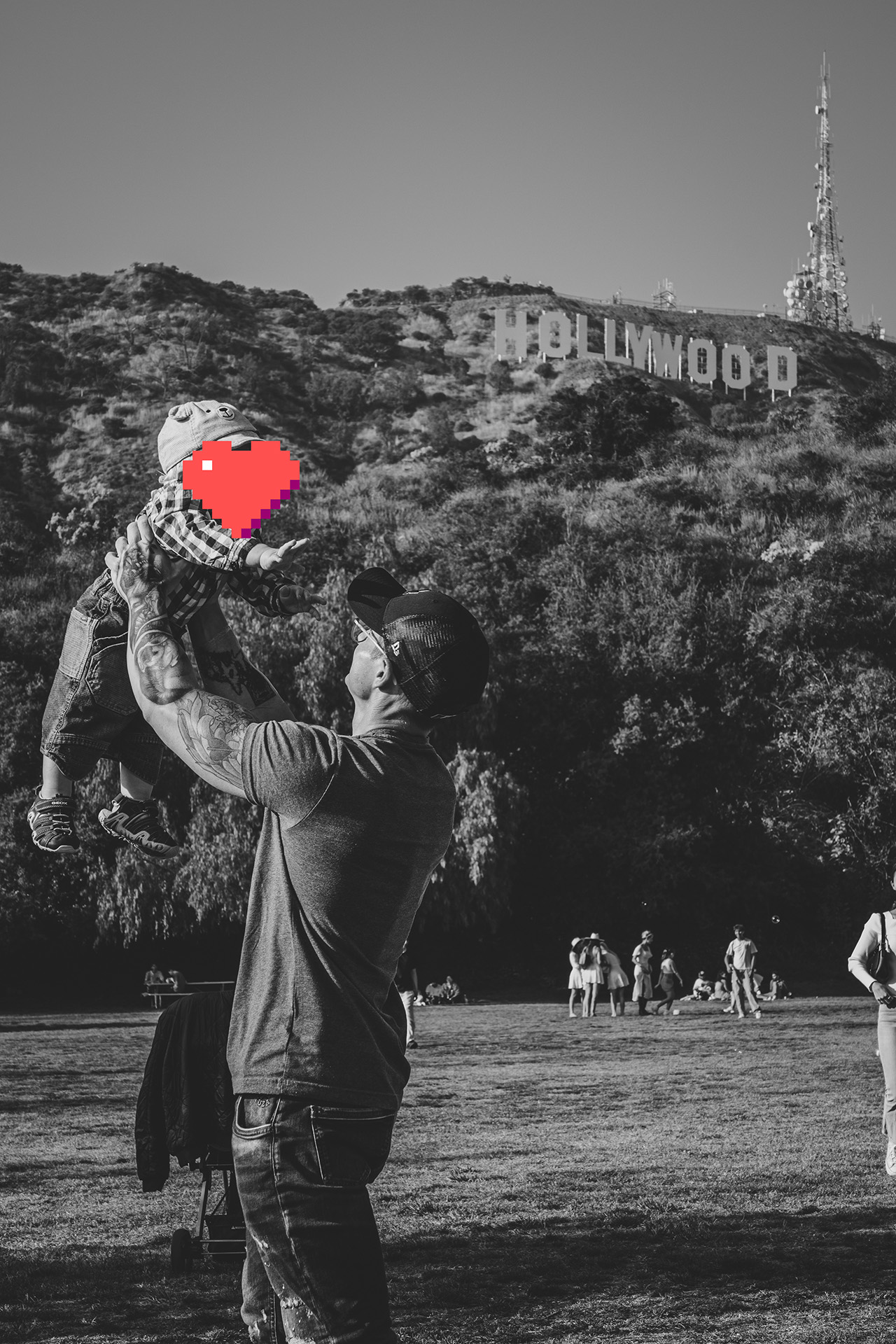 Me with my son in Los Angeles 2023, source: by author
Me with my son in Los Angeles 2023, source: by author
By 2025, that California dream had evolved into a complex ETL process of its own:
With two kids, a thriving career in Germany, and a burning desire to contribute to the U.S. tech scene, I approached the O-1A challenge like any other data problem: break it down, analyze the patterns, optimize the process, and scale the solution. What follows is not just the story of successfully obtaining an O-1A visa, but a journey that helped me become a better Data Engineer, father, husband, and ultimately, a happier person. This is my most personal and emotional article yet, but I believe that for the right reader, it might help make dreams come true. So if you’re ready, let’s discover how to transform your American dream from development to production.
How it felt: The beginning of the journey was both exciting and overwhelming. I felt lost at first, drowning in visa options that all seemed out of reach. What helped me navigate this uncertainty? First, consulting an immigration lawyer provided much-needed clarity. Second, journaling and note taking helped process my thoughts and track progress. But the most important lesson was learning to focus on one step at a time. Remember: you don’t need to have everything figured out on day one.
Every successful data pipeline needs reliable connections, and this journey proved that the most important connections aren’t in our code – they’re the people who support us along the way. I dedicate this article to my family: my incredible wife Natalie, my children Lara and Chester, my mom, my dad, who passed away when this journey started, and my amazing brother Ingo. To all my friends and colleagues who believed in me: this achievement is as much yours as it is mine. The biggest learning? Even the most extraordinary ability means nothing without extraordinary support.
I’m particularly grateful to my mentors and supervisors at InnoGames, Kay and Brett, whose guidance and support went far beyond professional development – they helped shape my journey and believed in my potential. To my incredible team at InnoGames: your collaboration and encouragement made this achievement possible. A special thanks to Yaakov and Xinran from Data Engineer Things for their unwavering support; I’m truly grateful for the wonderful connections this journey has brought into my life. These relationships, forged through professional collaboration, have grown into meaningful connections that made this dream achievable.
I also want to emphasize the power of sharing your story. Just as one well-documented solution can help countless developers solve similar problems, your experiences can light the way for others chasing their dreams. You never know who might be reading your content – your shared journey could be the spark that ignites someone else’s transformation, anywhere in the world.
Speaking of inspiration, I must acknowledge those who helped light my path. Shoutout to Sigil Wen, who made the number one video on getting the O-1 Extraordinary Ability Visa and is very active online helping others chasing their dreams.
And thanks to Sahar Mor for his great article about a systematic guide to successfully applying for an O1 visa, he even created a helpful Discord community all around the topic.
Remember: you’re not alone on this journey, even when the process feels isolating. Giving joy to others brings joy back.
Happiness lies in sharing.
As a German citizen and Data Engineer, I methodically explored various visa options, each with its own requirements and trade-offs. Here’s my analysis of the main pathways:
Three of these visas (L-1, H-1B, and O-1A) offer dual intent, meaning you can pursue permanent residency. The most logical follow-up paths are:
After extensive research and unsuccessful H-1B attempts, I chose the O-1A path. Why? No lottery meant no relying on luck – success would depend entirely on proving my abilities through work and passion.
A crucial note for families: dependent visa options vary significantly. With O-1A, my wife and children qualify for O-3 dependent visas. While this comes with limitations – no work authorization or Social Security Number for dependents – we decided as a family that the opportunity was worth these temporary constraints.
How it felt: The H-1B lottery experience was truly demotivating. Reading through Reddit forums about visa experiences only amplified the frustration – there’s so much negativity and uncertainty surrounding the H-1B process. My motivation hit a low point after the lottery rejection. This setback, however, led to a crucial realization: why leave my family’s future to chance? Choosing the O-1A path meant taking control of our destiny.
Every Data Engineer knows that timing is crucial when deploying a complex pipeline to production. The O-1A process was no different – it required careful planning, quick responses to errors, and precise execution. Here’s how my family’s American dream unfolded, complete with its own set of timestamps and status updates:
End of 2023: Started O-1A preparation
This was the longest-running job in our pipeline – collecting evidence, preparing documentation, and building the case for extraordinary ability. Like any good data architecture, the foundation had to be solid.
2024-10-10: USCIS received petition
The moment of truth – pushing our carefully prepared package to production. We opted for Premium Processing, which guarantees a response from USCIS within 15 business days, compared to regular processing that can take months.
2024-10-29: RFE notice received
A Request for Evidence (RFE) is USCIS’s way of saying they need additional documentation to make a decision. Any Data Engineer knows that feeling when your pipeline throws an unexpected error – but this wasn’t just about fixing a bug in some SQL query. This was about our family’s future. Two criteria have been accepted, so I focused on collecting more evidence for the others.
How it felt: After submitting the petition, I became obsessed with the Case Tracker app, checking it every hour, every day. The waiting period was mentally exhausting. When the status changed to RFE sent, my heart sank. After a year of dedicated work, self-doubt crept in: “Am I not good enough? Was I deluding myself about my abilities?” This was the lowest point in my journey, and I want to be honest: these feelings can lead to depression and burnout. What helped me recover was spending much more quality time with family, remembering why I started this journey, going the gym, and treating the RFE as a technical challenge rather than a personal failure. Remember: an RFE isn’t a rejection – it’s a request for clarification. Don’t let it define your worth or shake your confidence in your abilities.
2025-01-06: RFE response submitted
I approached the RFE like a critical production issue: analyze the requirements, gather additional evidence, and submit a comprehensive response. RFEs are common in O-1A petitions and shouldn’t be seen as a rejection – they’re an opportunity to strengthen your case.
2025-01-22: O-1A Approval Notice received
The first successful response from our pipeline – approval confirmed! This came in the form of an I-797 Notice of Action, the official USCIS approval notice.
How it felt: January 22nd started with my heart racing at the sight of a Case Tracker notification. After such a long journey, the decision was finally there, waiting. Yet I couldn’t bring myself to open the app immediately. I took a long shower, made my coffee, sat down, and closed my eyes for what felt like forever. When I finally gathered the courage to check, seeing “Approved” on the screen broke something inside me. Tears flowed freely – tears of relief, joy, and pride. Until that moment, this had been the hardest challenge I’d ever tackled, but also the most rewarding one. All those months of work, doubt, and persistence had finally paid off.
2025-02-06: Family visa interview
The final validation test – all family members present at the U.S. Consulate for our visa interview. For O-1A holders, spouses and unmarried children under 21 are eligible for O-3 dependent visas.
2025-02-07: Visas received
The fastest query response time in our entire process – just one day! As someone who optimizes data pipelines for a living, I couldn’t help but appreciate that efficiency. The visas came stamped in our passports, ready for our journey to the U.S.
Between these major milestones, numerous background processes were running simultaneously:
From initial preparation to final approval, the entire process took about 14 months. That might seem long, but remember: this wasn’t just another ETL job – this was transforming our family’s dream into reality. Each date in this timeline represents not just a milestone, but a step closer to our new life in California.
Pro tip: If you’re starting this journey, treat these timestamps as approximate ETAs for your own visa pipeline. Your actual processing times may vary, but having a reference architecture always helps in planning the deployment of your own American dream.
Imagine standing before eight gates, each representing a different path to proving extraordinary ability. That’s exactly where I found myself in 2023, analyzing these criteria. The USCIS recently updated their guidance for STEM professionals, making this an particularly exciting time for Data Engineers pursuing the O-1A visa.
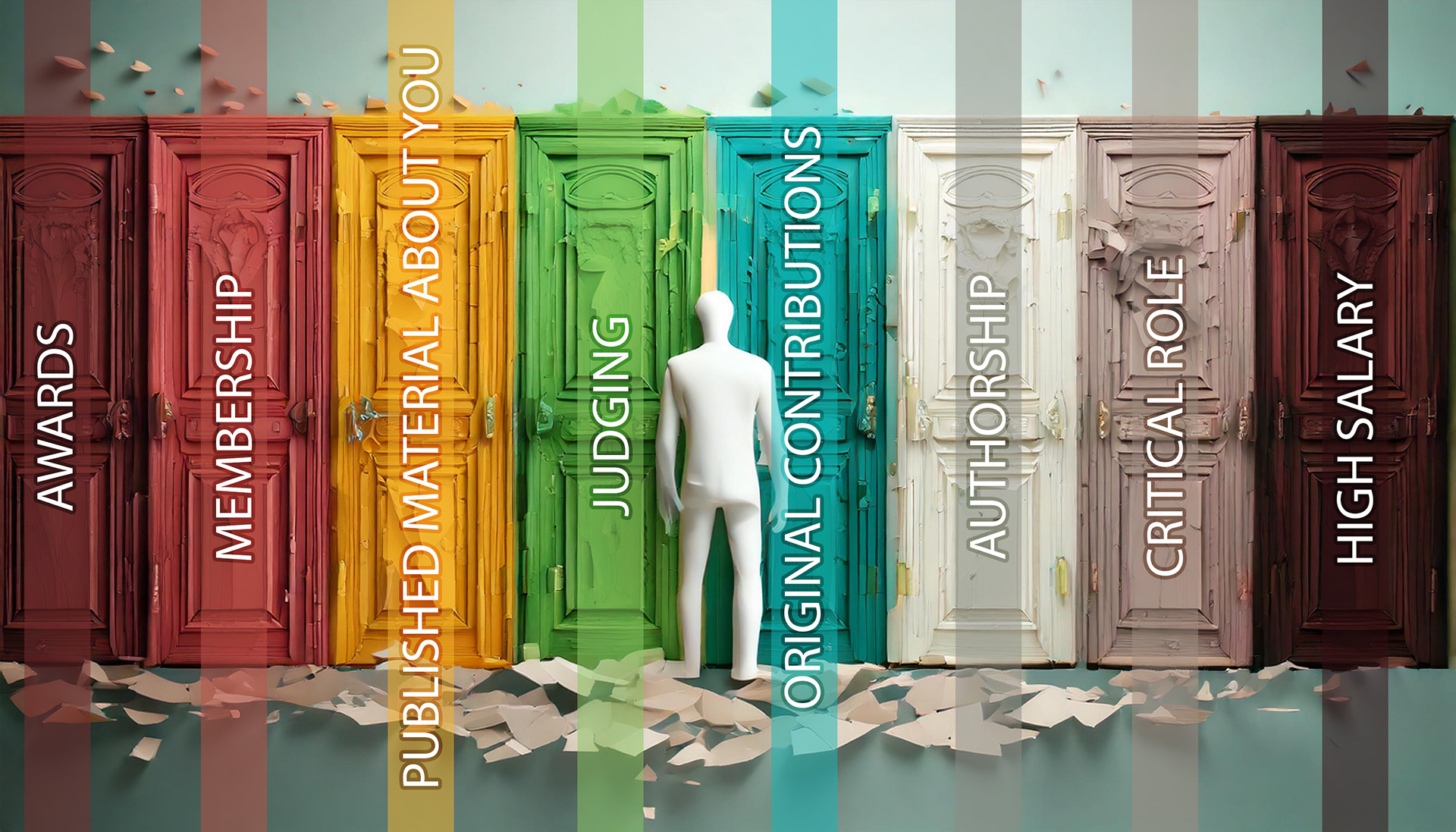 The eight gates to prove you are extraordinary, source: generated with Adobe Firefly
The eight gates to prove you are extraordinary, source: generated with Adobe Firefly
According to USCIS policy, you need to pass through at least three of these eight gates to demonstrate your extraordinary ability:
Think of these criteria as pipeline stages in your journey. Each one needs proper documentation, just as each stage in a data pipeline needs proper validation. The key isn’t just meeting three criteria – it’s weaving them into a coherent story that showcases your extraordinary ability in Data Engineering.
Or in the words of a Data Engineer:
-- Source System: Your Career
SELECT achievement FROM (
professional_experience,
side_projects,
publications,
speaking_engagements,
awards,
mentoring_activities,
salary_history,
leadership_roles
)
WHERE impact IS SIGNIFICANT
AND evidence IS DOCUMENTED
AND date >= 'last_5_years';In my case, I focused on the criteria that aligned naturally with my career path. Let me share how I transformed my technical experience into evidence. In the following chapters, I will share some highlights and key learnings of my O-1A petition.
Just as a well-designed data pipeline needs clean inputs to produce valuable outputs, your O-1A application needs meaningful achievements that demonstrate real business impact. As Data Engineers, we often get caught up in the technical elegance of our solutions – the perfect Kafka setup, the most efficient Flink job, or the cleanest code. However, for an O-1A visa, what matters most is not just how you built something, but why you built it and what impact it had.
Think of your career like a data warehouse: it’s not about storing every single project you’ve touched, but about maintaining the most valuable, well-documented, and impactful achievements. Before taking on new projects, always ask the “Spice Girls question”: “Tell me what you want, what you really, really want?” Understanding the business WHY behind technical requirements doesn’t just lead to better solutions – it creates the kind of measurable achievements that make O-1A applications compelling.
Consider these metrics when building your portfolio:
The key is positioning yourself as an irreplaceable asset in your organization’s data landscape. Don’t just be another engineer who can write SQL queries or build pipelines – become the person whose strategic input shapes the company’s data future. Step outside your comfort zone: join steering committees, participate in think tanks, or lead critical data initiatives. These roles not only build your expertise but create compelling evidence of your extraordinary ability.
When it comes to documentation, this strategic positioning pays dividends. A CTO or senior leader is far more likely to write a powerful recommendation letter when they can point to specific instances where your contributions were instrumental to the company’s success. Combine these letters with evidence about your employer’s market position and reputation, and you’ve built a strong case for the “critical role” criterion of the O-1A visa.
Remember: Immigration officers aren’t evaluating your code quality – they’re looking for evidence that you’re among the top Data Engineers in the field. This means demonstrating not just technical expertise, but business acumen and leadership. Challenge your employer to give you ownership of significant projects where you can drive measurable outcomes. Don’t be the engineer who touched a thousand projects – be the one who transformed critical business processes and can prove it with data.
This approach serves two purposes: it builds the kind of career achievements that make O-1A applications stronger, and it makes you a more valuable Data Engineer in the process. Even if you never pursue an O-1A visa, focusing on high-impact, measurable achievements and strategic leadership will accelerate your career growth. After all, extraordinary ability isn’t just about writing extraordinary code – it’s about delivering extraordinary results and becoming truly indispensable to your organization.
In 2024, I participated in various hackathons. Devpost proved to be an excellent platform for this, offering easy online registration and hosting numerous AI-related hackathons with high reach and impact – making it particularly valuable for Data Engineers looking to demonstrate their skills.
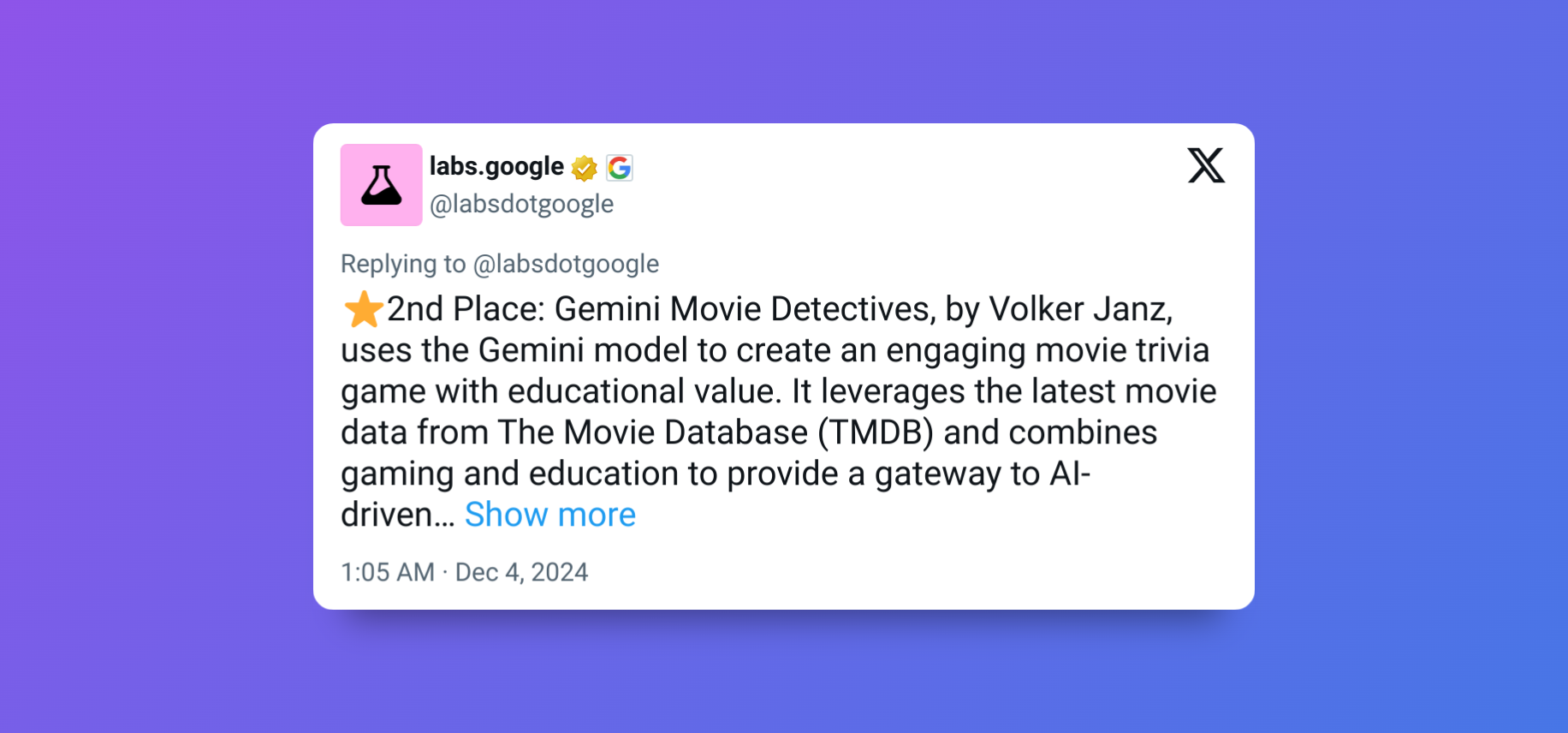 Google post about my hackathon win, source: post on X.com
Google post about my hackathon win, source: post on X.com
One of the major competitions I entered was the Google AI Hackathon 2024. With over 15,000 participants, experienced judges from Google, and many professionals competing, this was a real challenge. The hackathon tasked participants with building creative applications using Google’s Generative AI tools with Gemini, inviting developers worldwide to showcase their innovation.
The result exceeded my expectations: I won Second Place Overall among the 15,000 participants! This significant achievement helped fulfill the awards criterion for my visa petition. However, securing the achievement was only the first step. The second, equally crucial phase involved gathering evidence. For this, I compiled screenshots, confirmations, and even reached out to the organizers for additional documentation. I discovered that people are often more willing to help than you might expect.
While winning such a hackathon is incredible, participating can feel overwhelming. Here’s my advice: Don’t overthink it. Imagine you’re casually tossing your phone in the air and catching it; you can do this all day without worry. But if you stand over a five-foot balcony and try the same thing, your heart rate spikes, you get nervous, you sweat, and you might actually drop your phone—the very thing you were worried about happens because you were overthinking.
Also, always think about derivative content! Every achievement in your career can open new doors. Maintain momentum and go with the flow. Take every chance, no matter how far outside your comfort zone it might seem. For example: right after winning the hackathon, I was able to give an interview to Devpost which was published on their platform, directly contributing to the Published Material About You category.
This category can be challenging, as most qualifying memberships take significant time to achieve. Let’s understand what USCIS is looking for:
Documentation of the beneficiary’s membership in associations in the field for which classification is sought, which require outstanding achievements of their members, as judged by recognized national or international experts in their disciplines or fields.
In simple terms, you need membership in organizations that:
Here’s a myth worth debunking: paid memberships aren’t automatically denied. While many paid memberships might lack value for visa purposes, it’s common even for prestigious memberships to charge administrative fees. The key is the membership’s selectivity and recognition, not its cost.
For this criterion, I pursued IEEE membership. The Institute of Electrical and Electronics Engineers is a global organization advancing technology for humanity’s benefit, uniting professionals in electrical engineering, computer science, and related fields. However, basic IEEE membership isn’t enough – I aimed for IEEE Senior membership, which can fulfill the O-1A criterion (while EB-1A typically requires IEEE Fellowship).
IEEE Senior membership requires:
Finding referees might seem daunting, but I used IEEE’s social platform Collabratec to connect with potential referees. It takes effort, but it’s definitely achievable.
I also secured membership in The Astronomer Champions Program for Apache Airflow, a global initiative recognizing passionate advocates of Apache Airflow technology. This membership requires demonstrated dedication through published articles or conference presentations.
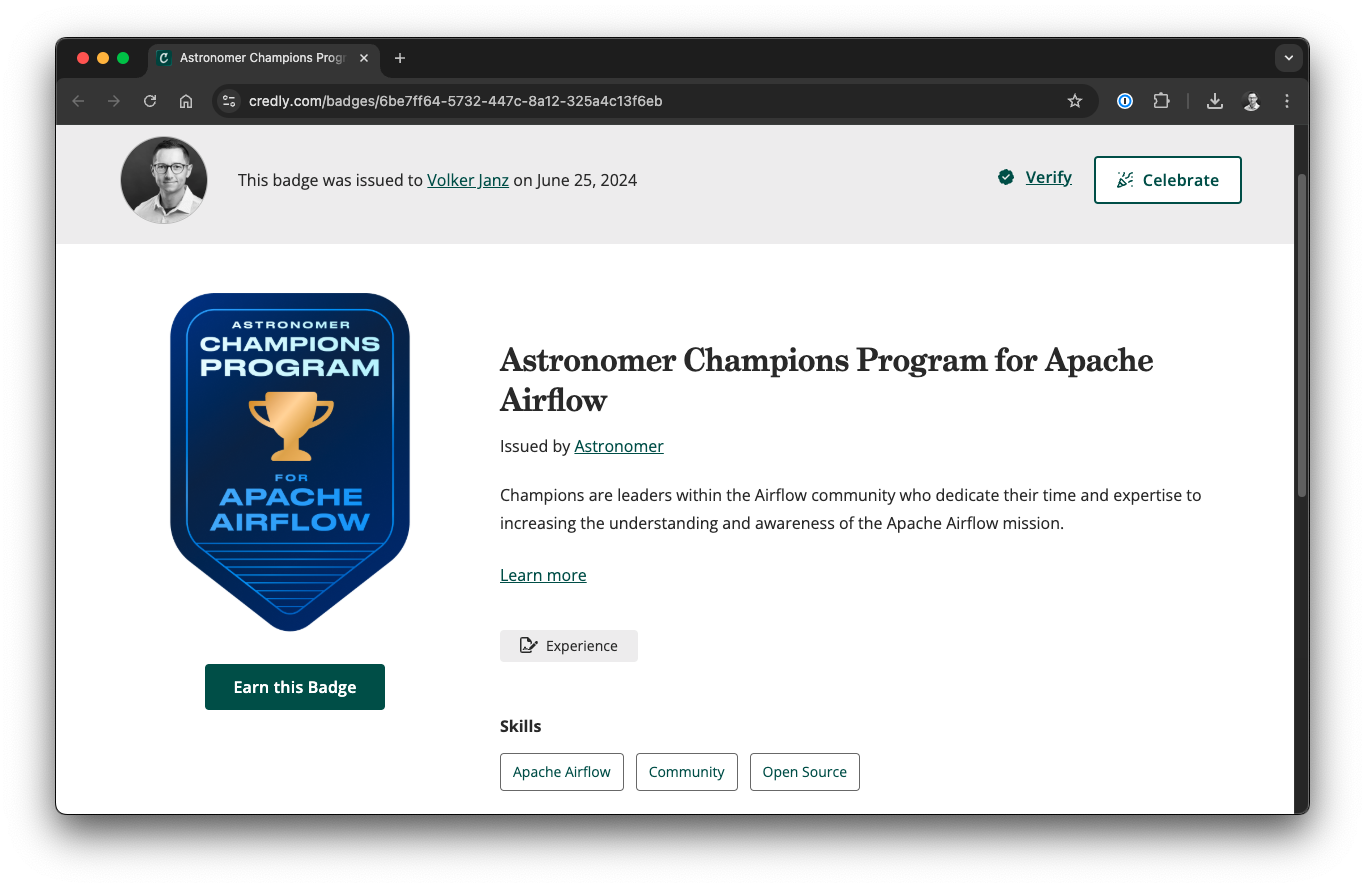 Astronomer Champions badge, source: credly.com
Astronomer Champions badge, source: credly.com
Pro tip: Look for specific memberships in your expertise area, like I did with Apache Airflow. While these might be less common, USCIS officers often value them highly because they’re based purely on ability rather than paid membership. Strong documentation of these achievements can make them powerful evidence for your petition.
The classic approach to fulfilling this criterion is through hackathon judging. The strategy is straightforward but requires dedication: aim to judge 2-3 events to build a solid foundation of evidence. Success here isn’t about luck – it’s about consistent effort and outreach.
I approached this systematically, spending several weeks researching and contacting hackathon organizers across Europe. The key is persistence: look up upcoming events in your area and reach out proactively. When approaching organizers, I focused on the value I could bring to their events. I highlighted my technical expertise, offered to provide mentoring during the event, and emphasized how my network could benefit their hackathon’s visibility.
Here’s a practical tip: be transparent about your motivation. I found that being honest about how this would support my immigration journey actually helped – organizers often appreciate the dedication this shows. Be prepared to invest time and effort, including travel if necessary. After all, demonstrating extraordinary ability sometimes means going the extra mile (literally!).
For my petition, I successfully judged three hackathons. Each experience not only provided valuable evidence through thank you letters and event documentation but also expanded my professional network. Remember: while you’re building your visa case, you’re also growing as a professional.
As you might tell, I love writing. In 2024, I went all in to secure this category for my visa, authoring 17 articles published in leading Data Engineering publications including Data Engineer Things, Towards Data Science, BigData-Insider, and Computerwoche.
If you’re passionate about your work, finding topics to share comes naturally. However, the key lies in gathering the right evidence. Two critical aspects to focus on:
Pro tip: Use similarweb.com for free visitor statistics. Here’s a general guideline: Niche industry publications: 100-250k monthly visitors needed to be distinguished, general publications: 500k-1,000,000 monthly visitors needed to be distinguished.
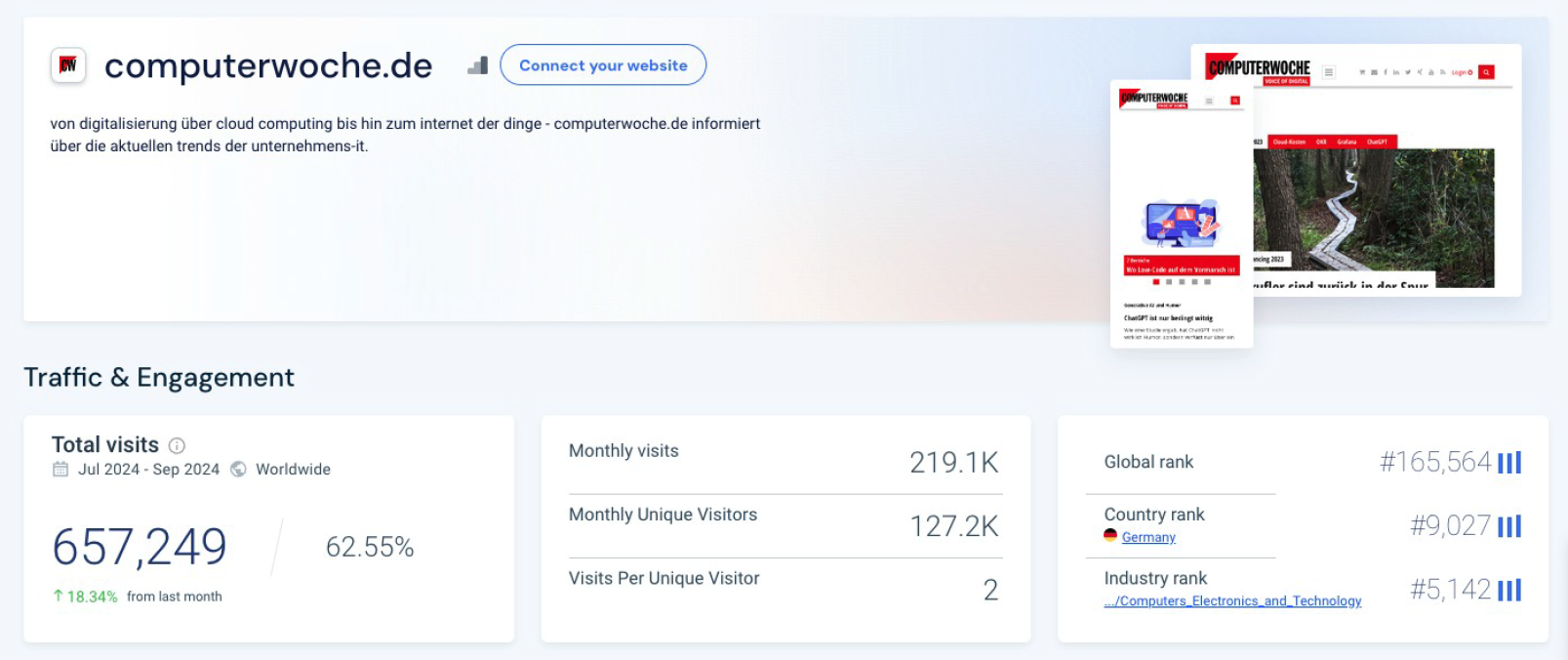 Visitor statistics, source: similarweb.com
Visitor statistics, source: similarweb.com
Here’s where my story takes an interesting turn. Remember the RFE I mentioned? While initially shocking, it provided valuable insights about additional evidence I could submit. The officer specifically noted:
Evidence of the Beneficiary’s presentations at international conferences highlights the recognition of their expertise and the acceptance of their work by professional and academic communities on a global scale.
This was a golden opportunity – presenting at international conferences had been my passion for over a decade. I added evidence of talks at the Big Data Conference Europe 2023 in Vilnius, Lithuania, and the Big Data Technology Warsaw Summit 2021 in Warsaw, Poland, where I received the best presentation award.
Key learning: RFEs aren’t setbacks – they’re opportunities to strengthen your case with detailed guidance from USCIS themselves. Take them as a chance to make your petition even stronger.
As any experienced Data Engineer knows, the most critical pipeline components are often the least discussed. While most guides focus on the eight criteria, let me share two crucial aspects that often fly under the radar.
Every O-1A petition requires an advisory opinion letter - think of it as a peer review for your extraordinary ability. Traditionally, this comes from a U.S. peer group or labor organization in your field. However, here’s the catch: many fields, especially in technology, don’t have established peer groups.
In such cases, and I also recommend this for Data Engineers, you can submit an advisory opinion from an individual expert who:
Pro tip: Build these connections early. Be active in the Data Engineering community, join podcasts, participate in discussions, and help others. Your network is as crucial as your achievements.
If an agent is involved, the agent relationship in your O-1A petition requires clear documentation. An agent can be either a U.S. employer or a U.S. person/company authorized to act on behalf of both you and potential employers.
USCIS requires clear evidence of:
Pro tip: Include supplemental letters that clearly explain the agent structure. Many RFEs are issued simply because the officer couldn’t understand the agent relationship. Think of it like commenting your code – the clearer the documentation, the smoother the process.
Remember: Just as undocumented dependencies can break a pipeline, unclear agent relationships or missing advisory opinions can derail your petition. Address these requirements early to avoid RFEs later.
Once you receive your O-1A approval, it’s time for the final transform and load operations: the visa interview. Here’s my experience navigating this final challenge with my family.
The process starts at ustraveldocs.com, where you’ll find comprehensive documentation. Here’s the execution plan:
For O-1A Applicant:
For Family Members (O-3):
Pro tip: While bringing your printed petition is recommended, I didn’t need mine during the interview. However, better safe than sorry.
The good news? All those hours spent building your petition weren’t just for USCIS – they’ve prepared you well for any interview questions. Practice concise, impactful answers to basics like “What is your field of expertise?” and “What makes you extraordinary in your field?”
Remember: Dress professionally and be yourself. You’ve earned your place at this stage through hard work and proven extraordinary ability. This isn’t just another technical interview – it’s the final step in deploying your American dream to production.
 Me right before the visa interview February 2025, source: by author
Me right before the visa interview February 2025, source: by author
How it felt: The visa interview felt more stressful than it needed to be, mainly because I’d read too many horror stories online. In reality, it was friendly and relatively relaxed. The questions were straightforward, and all that work building the petition had naturally prepared me for them. Still, sitting across from a consular officer who holds the key to your dreams is intimidating – it’s the final hurdle after all that hard work. My typical engineer response? Over-preparation. And you know what? It worked.
Remember: The O-1A process isn’t just about proving extraordinary ability – it’s about becoming truly extraordinary in your field. Every step should make you better at what you do, regardless of the outcome.
Looking back at those early days of research and uncertainty, I see now that pursuing the O-1A wasn’t just about proving extraordinary ability – it was about extraordinary determination. From those first motorcycle rides along the Pacific Coast Highway to late nights crafting evidence packages while my kids slept, every step of this journey has been about family as much as career.
The process challenged me to become not just a better Data Engineer, but a more resilient father and husband. It taught our children about pursuing dreams, no matter how distant they seem. And it showed me that true extraordinary ability isn’t just about what you can do with code – it’s about what you’re willing to do for the people you love.
 My children waiting to board our flight to Los Angeles, source: by author
My children waiting to board our flight to Los Angeles, source: by author
To my fellow Data Engineers considering this path: your skills are more valuable than you might think, and your impact more significant than you realize. The same analytical mindset that makes you great at processing data can help you process this challenge. Just remember – the most important queries aren’t the ones you write in SQL, but the ones you ask yourself about what you really want to achieve.
From Hamburg to Hollywood, from processing data to processing dreams – this journey has been the most challenging and rewarding pipeline I’ve ever built. And now, as my family prepares for our new life in California, I can confidently say that the O-1A isn’t just a visa – it’s proof that with enough determination, the right support, and a solid strategy, extraordinary dreams can become extraordinary reality.
Are you on a similar journey? Whether you’re just starting to explore the O-1A path or deep in the evidence-gathering phase, I’m happy to share more insights and advice. Connect with me on LinkedIn.
Remember how others’ shared experiences helped light my path? Now it’s my turn to pay it forward.
The best queries are the ones we solve together.
